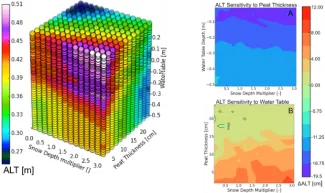An ensemble of 7,392 one-dimensional thermal hydrology model simulations with the Advanced Terrestrial Simulator (ATS) were used to investigate the role of three environmental factors, 1) thickness of organic rich soil, 2) snow depth, and 3) water table position above or below the soil surface (inundation state), in determining active layer thickness (ALT). Adam Atchley and his colleagues at LANL observed that ALT of the ensemble ranged from 25 to 51 cm, which is well within the range observed from manual and geophysical measurements at the NGEE Arctic field site on the Barrow Environmental Observatory (BEO), Barrow, AK. However, Atchley et al. felt that the variation was large considering that only three environmental variables were tested. Further exploration of the ensemble revealed the isolated influence of each environmental condition on ALT as well as mixed effects. Sensitivities of ALT to changes in environmental conditions are determined. Results show that the organic layer acts as a strong insulator and its thickness is the dominant control on ALT, with a thicker layer resulting in a shallower active layer. Although the strength of the effect of organic layer thickness on ALT is dependent on the saturation state, an intact organic layer will always insulate permafrost from temperature extremes relative to mineral soil. Snow depth and water table position are both positively correlated to ALT, but interactions between the two controls are strong. As conditions change due to climate impacts or along environmental gradients, the results of this investigation can be used to identify how emerging combinations of snow depth, peat thickness, and soil moisture will determine ALT.
In Figure 1, Plots at right show the sensitivity of ALT to peat (top) and inundation state (bottom), showing that peat is the strongest control (largest magnitude sensitivity) while the sensitivity of ALT to inundation state is highly dependent upon peat thickness.
The full ensemble is shown with a snowfall multiplier range from 0 to 3 , which results in an approximate snow depth range between 0 and 1.2 meters, peat organic layer thickness from 2 to 24cm, and a water table depth range from -0.51 meters (below soil surface) to 0.31 meters (above soil surface).
For more information, please contact:
Adam Atchley
aatchley@lanl.govEthan Coon
coonet@ornl.govDylan Harp
dharp@lanl.govScott Painter
paintersl@ornl.govCathy Wilson
cjw@lanl.gov

